CHEVROLET CORVETTE 1996 4.G Owner's Guide
Manufacturer: CHEVROLET, Model Year: 1996, Model line: CORVETTE, Model: CHEVROLET CORVETTE 1996 4.GPages: 386, PDF Size: 20.12 MB
Page 31 of 386
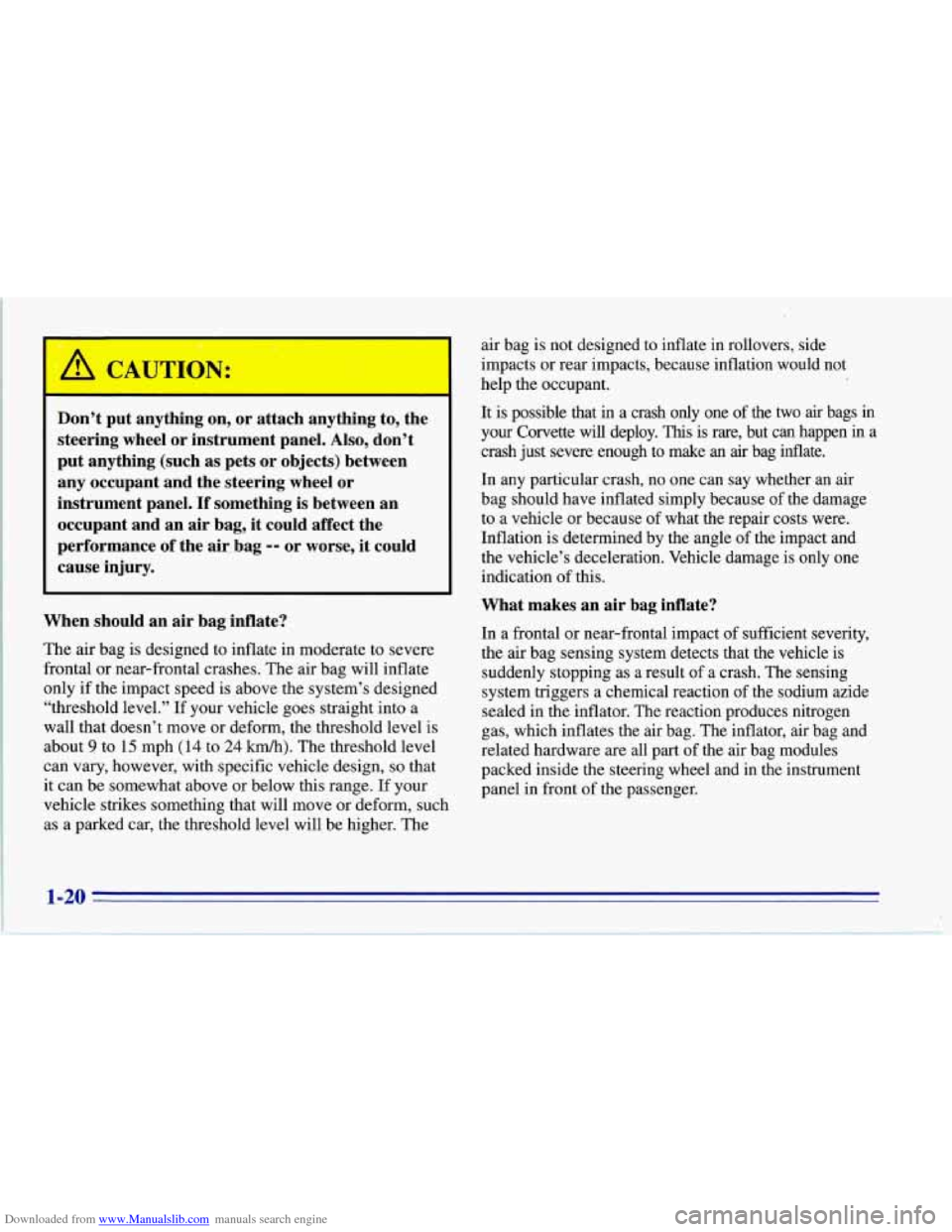
Downloaded from www.Manualslib.com manuals search engine .. I- ‘ ,
Don’t put anything on, or attach anything to, the
steering wheel or instrument panel. Also, don’t
put anything (such as pets or objects) between
any occupant and the steering wheel or
instrument panel. If something is between an
occupant and an air bag, it could affect the
performance of the air, bag
-9 or worse, it could
cause injury.
When should
an air bag inflate?
The air bag is designed to inflate in moderate to severe
frontal or near-frontal crashes. The air bag will inflate
only if the impact speed is above the system’s designed
“threshold level.” If your vehicle goes straight into a
wall that doesn’t move or deform, the threshold level is
about
9 to 15 mph (14 to 24 km/h). The threshold level
‘can vary, however, with specific vehicle design,
so that
it can be somewhat above or below this range. If your
vehicle strikes something that will move or deform, such
as a parked car, the threshold level will be higher. The air
bag is not designed to inflate in rollovers, side
impacts or rear impacts, because inflation would not
help the occupant.
It is possible that in a crash only one of the two
air bags in
your Corvette will deploy. This is rare, but can happen in a
crash just severe enough to make
an air bag inflate.
In any particular crash, no one can say whether an air
bag should have inflated simply because of the damage
to a vehicle or because of what the repair costs were.
Inflation
is determined by the angle of the impact and
the vehicle’s deceleration. Vehicle damage is only one
indication of this.
What makes an air bag inflate?
In a frontal or near-frontal impact of sufficient severity,
the air bag sensing system detects that the vehicle is
suddenly stopping as a result of a crash. The sensing
system triggers a chemical reaction of the sodium azide
sealed in the inflator. The reaction produces nitrogen
gas, which inflates the air bag. The inflator, air bag and
related hardware are all part
of the air bag modules
packed inside the steering wheel and in the instiument
panel in front of the passenger.
Page 32 of 386
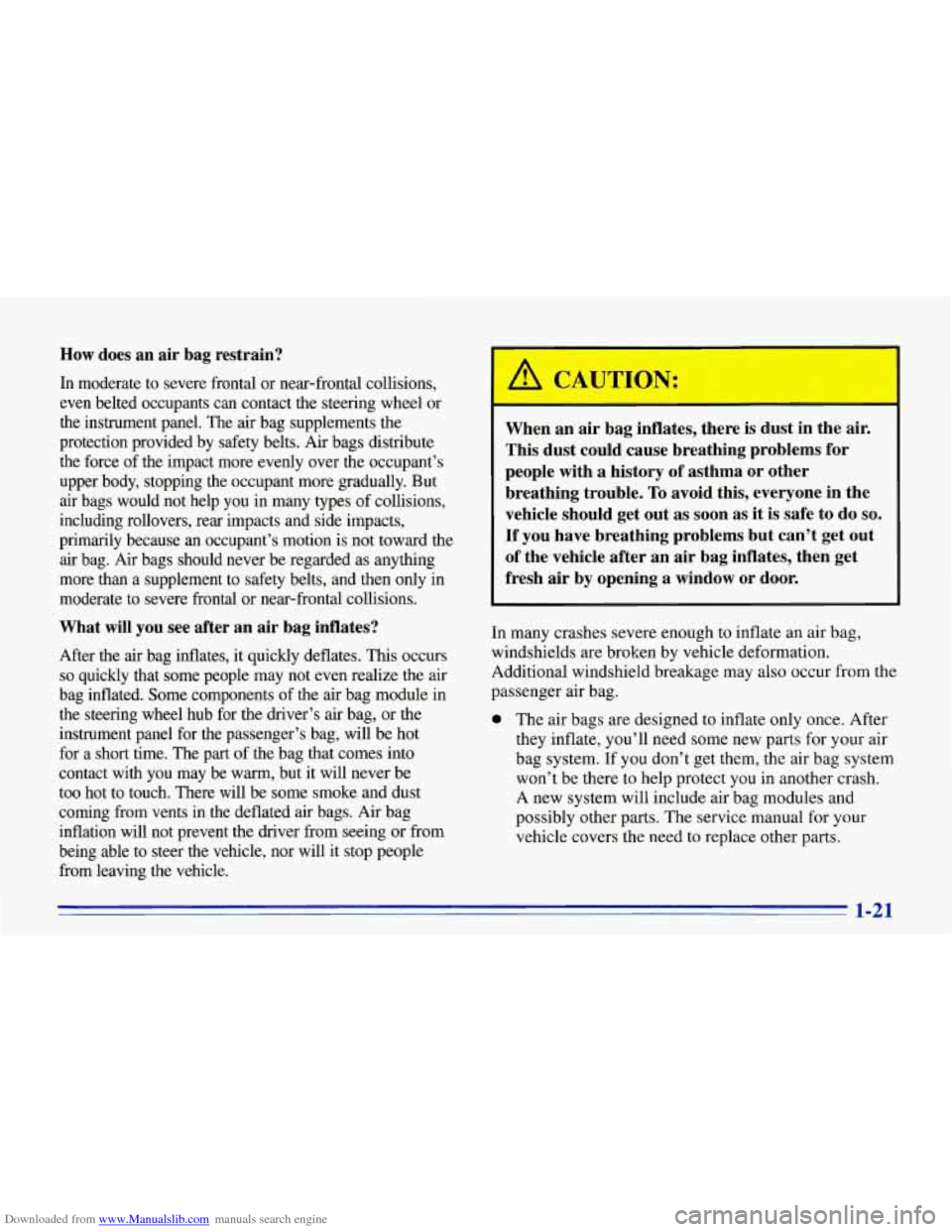
Downloaded from www.Manualslib.com manuals search engine How does an air bag restrain?
In moderate to severe frontal or near-frontal collisions,
even belted occupants can contact the steering wheel or
the instrument panel. The air bag supplements the
protection provided by safety belts. Air bags distribute
the force of the impact more evenly over the occupant’s
upper body, stopping the occupant more gradually. But air bags would not help you in many types
of collisions,
including rollovers, rear impacts and side impacts,
primarily because
an occupant’s motion is not toward the
air bag. Air bags should never be regarded as anything
more than a supplement to safety belts, and then only in
moderate to severe frontal or near-frontal collisions.
What will you see after an air bag inflates?
After the air bag inflates, it quickly deflates. This occurs
so quickly that some people may not even realize the air
bag inflated. Some components of the air bag module in
the steering wheel hub for the driver’s air bag, or the
instrument panel for the passenger’s bag, will be hot
for a short time. The part of the bag that comes into
contact with you may be warm, but it will never be
too hot to touch. There will be some smoke and dust
coming from vents
in the deflated air bags. Air bag
inflation will not prevent the driver from seeing or from
being able to steer the vehicle, nor will it stop people
from leaving the vehicle.
When an air bag inflates, there is dust in the air.
This dust could cause breathing problems for
people with a history
of asthma or other
breathing trouble. To avoid this, everyone in the
vehicle should get out
as soon as it is safe to do so.
If you have breathing problems but can’t get out
of the vehicle after an air bag inflates, then get
fresh air by opening a window or door.
n many crashes severe enough to inflate an air bag,
windshields are broken by vehicle deformation.
Additional windshield breakage may also occur from the
passenger air bag.
0 The air bags are designed to inflate only once. After
they inflate, you’ll need some new parts for your air
bag system. If
you don’t get them, the air bag system
won’t be there to help protect you in another crash.
A new system will include air bag modules and
possibly other parts. The service manual for your
vehicle covers the need to replace other parts.
1-21
Page 33 of 386
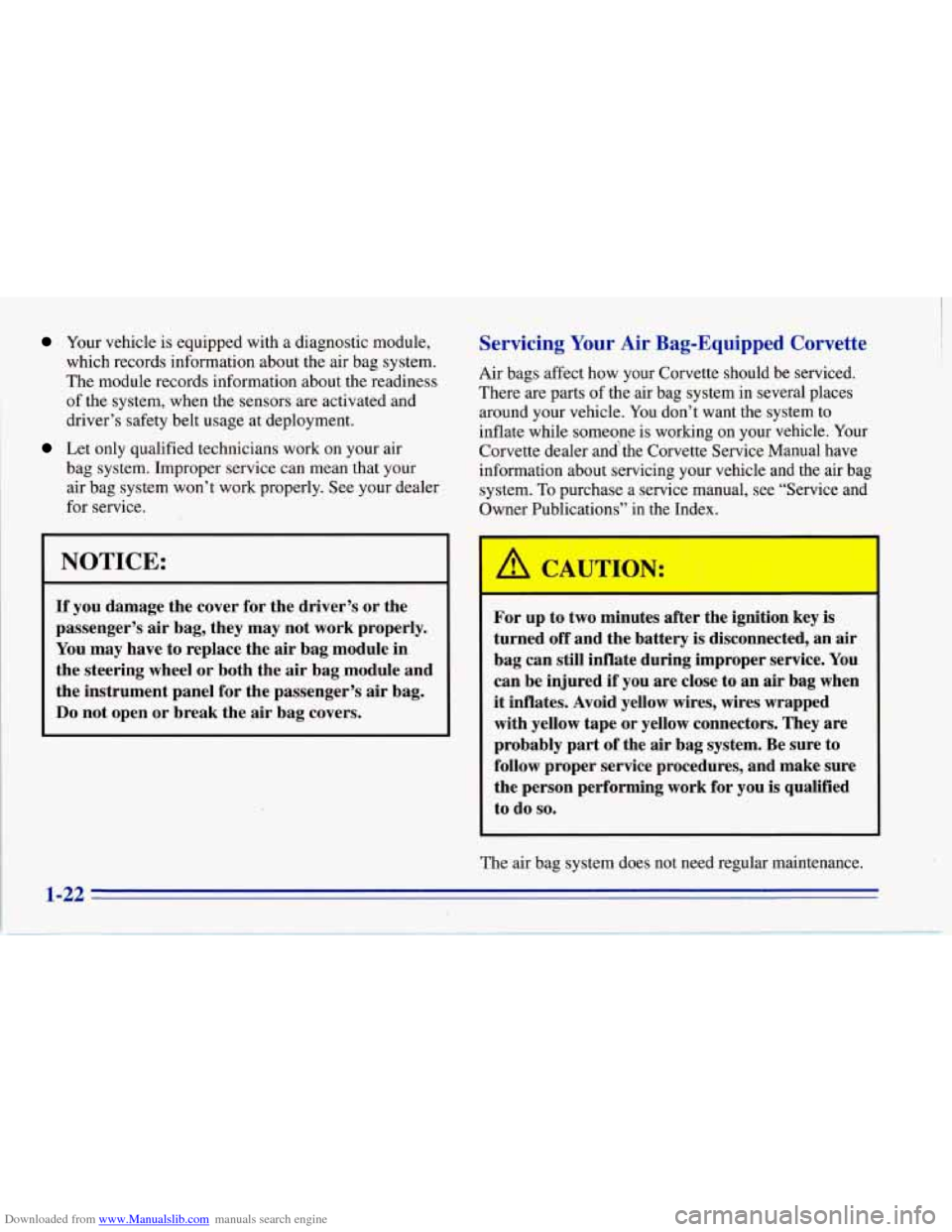
Downloaded from www.Manualslib.com manuals search engine Your vehicle is equipped with a diagnostic module,
which records information about the air bag system.
The module records information about the readiness
of the system, when the sensors are activated and
driver’s safety belt usage at deployment.
Let only qualified technicians work on your air
bag system. Improper service can mean that your
air bag system won’t work properly. See your dealer
for service.
NOTICE:
If you damage the cover for the driver’s or the
passenger’s air bag, they may not work properly.
You may have to replace the air bag module in
the steering wheel or both the air bag module and
the instrument panel for the passenger’s air bag.
Do not open or break the air bag covers.
Servicing Your Air Bag-Equipped Corvette
Air bags affect how your Corvette should be serviced.
There are parts of the air bag system in several places
around your vehicle.
You don’t want the system to
inflate while someone is working on your vehicle. Your
Corvette dealer and‘the Corvette Service Manual have
information about servicing your vehicle and the air bag
system. To purchase a service manual, see “Service and
Owner Publications” in the Index.
For up to two minutes after the ignition key is
turned
off and the battery is disconnected, an air
bag can still inflate during improper service.
You
can be injured if you are close to an air bag when
it inflates. Avoid yellow wires, wires wrapped
with yellow tape or yellow connectors. They are
probably part of the air bag system. Be sure to
follow proper service procedures, and make sure
the person performing work for you is qualified
to do
so.
The air bag system does not need regular maintenance.
1-22
Page 34 of 386
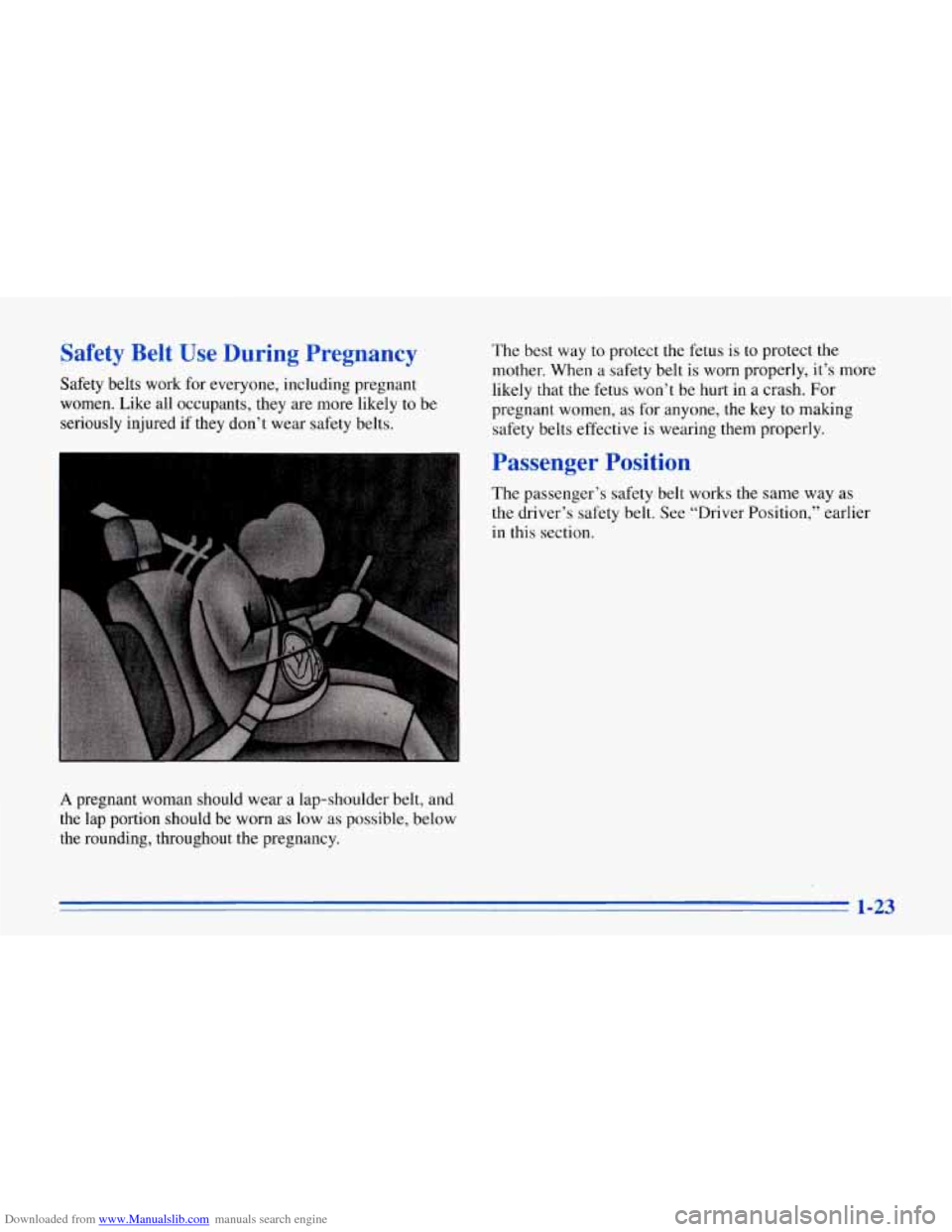
Downloaded from www.Manualslib.com manuals search engine Safety Belt Use During Pregnancy
Safety belts work for everyone, including pregnant
women. Like
all occupants, they are more likely to be
seriously injured if they don’t wear safety belts. The
best way to protect the
fetus is to protect the
mother. When a safety belt
is worn properly, it’s more
likely that the fetus won’t be hurt in a crash. For
pregnant women, as for anyone, the key to making
safety belts effective is wearing them properly.
A pregnant woman should wear a lap-shoulder belt, and
the lap portion should be worn as low as possible, below
the rounding, throughout the pregnancy.
Passenger Position
The passenger’s safety belt works the same way as
the driver’s safety belt. See “Driver Position,” earlier
in this section.
1-23
Page 35 of 386
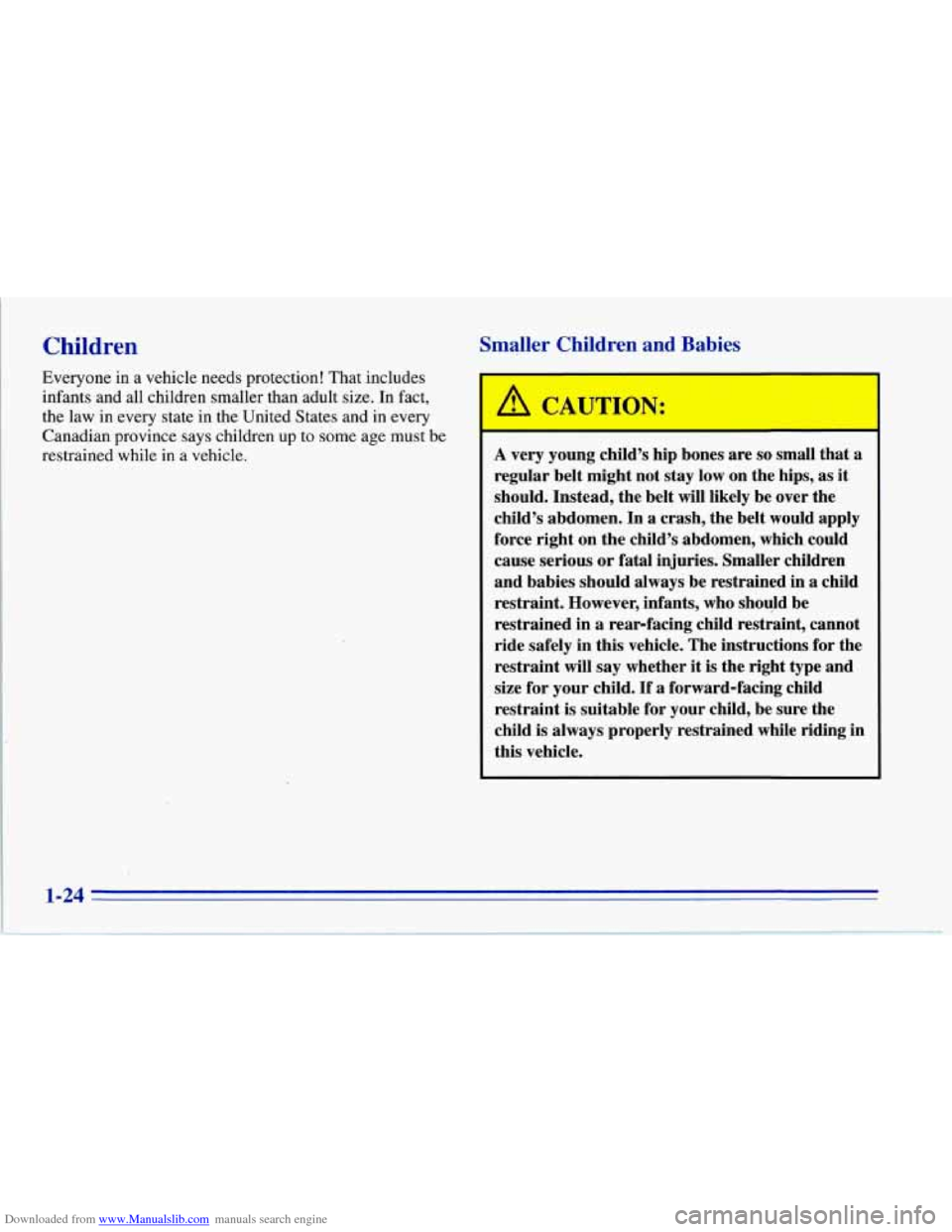
Downloaded from www.Manualslib.com manuals search engine Children Smaller Children and Babies
Everyone in a vehicle needs protection! That includes
infants and all children smaller than adult size. In fact,
the law in every state in the United States and
in every
Canadian province says children up to some age must be
restrained while in a vehicle.
I
A CAUTION: A Q
A very young child’s hip bones are so small that a
regular belt might not stay low on the hips, as it
should. Instead, the belt will likely be over the
child’s abdomen. In
a crash, the belt would apply
force right on the child’s abdomen, which could
cause serious or fatal injuries. Smaller children
and babies should always be restrained in a child
restraint. However, infants, who should be
restrained in a rearfacing child restraint, cannot
ride safely in this vehicle. The instructions for the
restraint will
say whether it is the right type and
size for your child.
If a forward-facing child
restraint
is suitable for your child, be sure the
child
is always properly restrained while riding in
this vehicle.
1-24
Page 36 of 386

Downloaded from www.Manualslib.com manuals search engine Never hold a baby in your arms while riding in a
vehicle.
A baby doesn't weigh much -- until a
crash. During a crash a baby will become so
heavy you can't hold it. For example, in a crash
at only 25 mph
(40 km/h), a 12-lb. (5.5 kg) baby
will suddenly become
a 240-lb. (110 kg) force on
your arms. The baby would be almost impossible
to hold.
1-25
Page 37 of 386
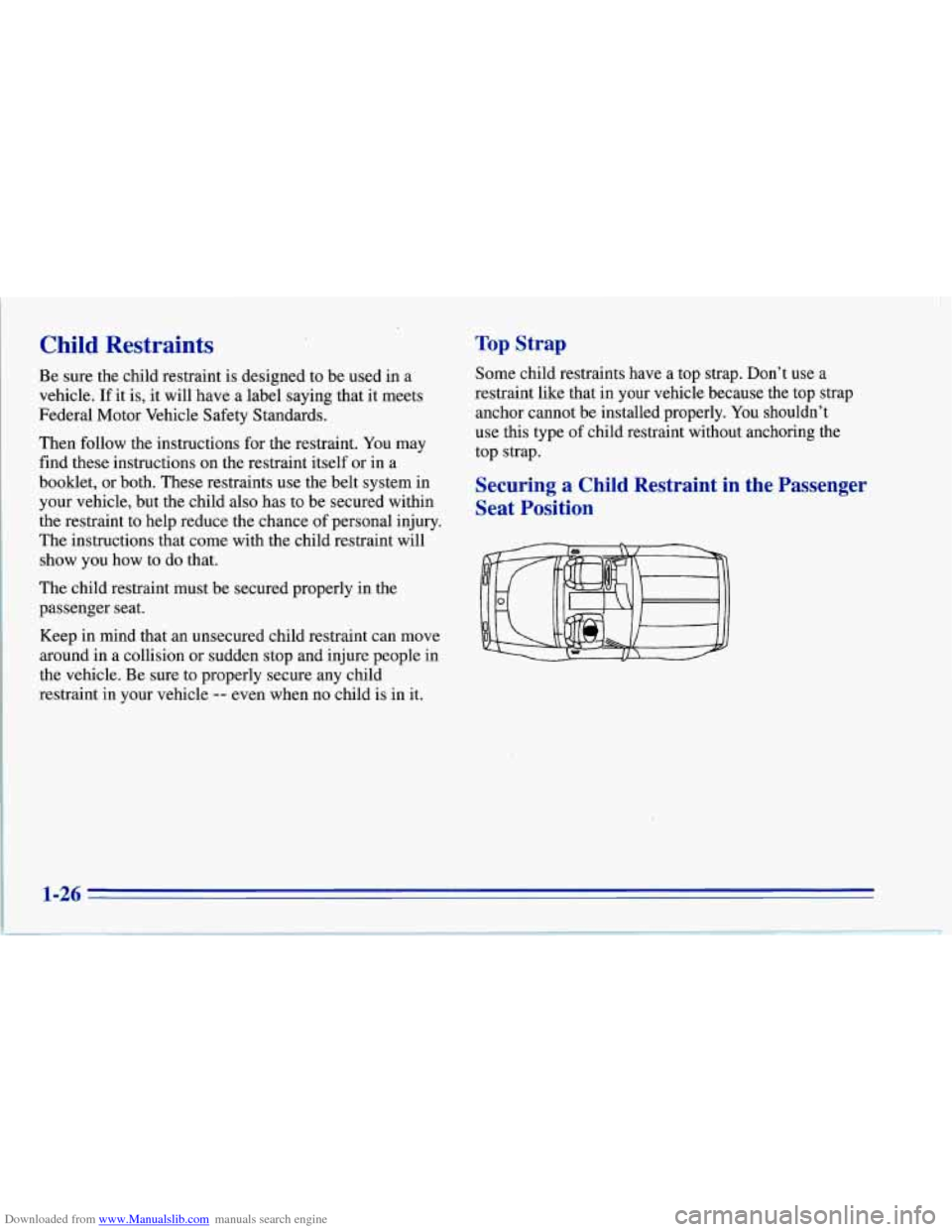
Downloaded from www.Manualslib.com manuals search engine Child Restraints Top Strap
Be sure the child restraint is designed to be used in a
vehicle.
If it is, it will have a label saying that it meets
Federal Motor Vehicle Safety Standards.
Then follow the instructions for the restraint. You may
find these instructions on the restraint itself or in a
booklet, or both. These restraints use the belt system in
your vehicle, but the child also has to be secured within
the restraint to help reduce the chance
of personal injury.
The instructions that come with the child restraint will
show you how to do that.
The child restraint must be secured properly in the
passenger seat.
Keep in mind that an unsecured child restraint can move
around in a collision or sudden stop and injure people in
the vehicle. Be sure to properly secure any child
restraint in your vehicle
-- even when no child is in it. Some
child restraints have a top strap. Don’t use a
restraint like that in your vehicle because the top strap
anchor cannot be installed properly.
You shouldn’t
use this type
of child restraint without anchoring the
top strap.
Securing a Child Restraint in the Passenger
Seat Position
1-26
Page 38 of 386
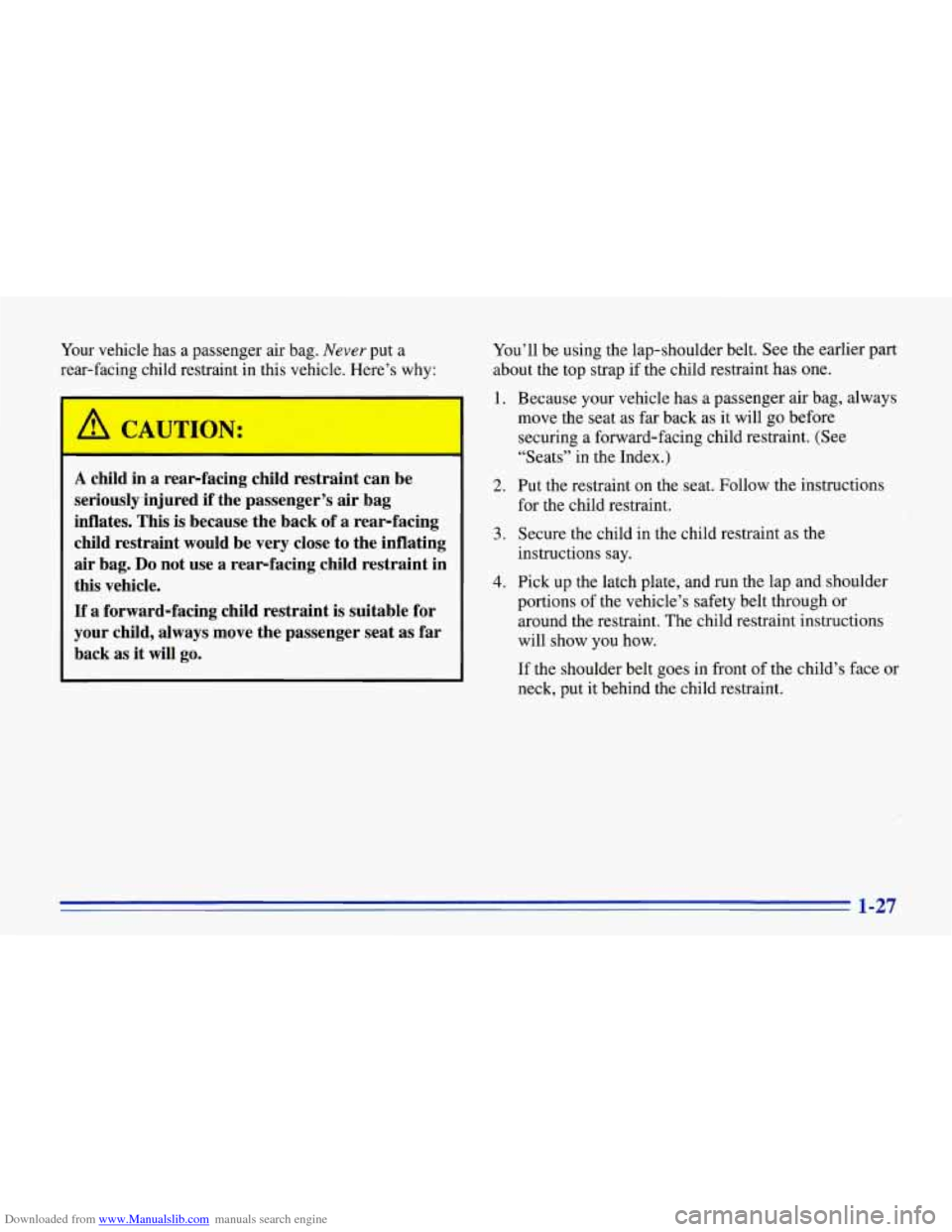
Downloaded from www.Manualslib.com manuals search engine Your vehicle has a passenger air bag. Never put a
rear-facing child restraint in this vehicle. Here’s why:
a CAW TION:
A child in a rear-facing child restraint can be
seriously injured if the passenger’s air bag
inflates. This is because the back of a rear-facing
child restraint would be very close to the inflating
air bag.
Do not use a rear-facing child restraint in
this vehicle.
If a forward-facing child restraint is suitable for
your child, always move the passenger seat as far
back as it will
go.
You’ll be using the lap-shoulder belt. See the earlier part
about the top strap
if the child restraint has one.
1. Because your vehicle has a passenger air bag, always
move the seat as far back as it will go before
securing a forward-facing child restraint. (See
“Seats” in the Index.)
2. Put the restraint on the seat. Follow the instructions
for the child restraint.
3. Secure the child in the child restraint as the
instructions say.
4. Pick up the latch plate, and run the lap and shoulder
portions of the vehicle’s safety belt through or
around the restraint. The child restraint instructions
will show you how.
If the shoulder belt goes in front of the child’s face or
neck, put it behind the child restraint.
1-27
Page 39 of 386
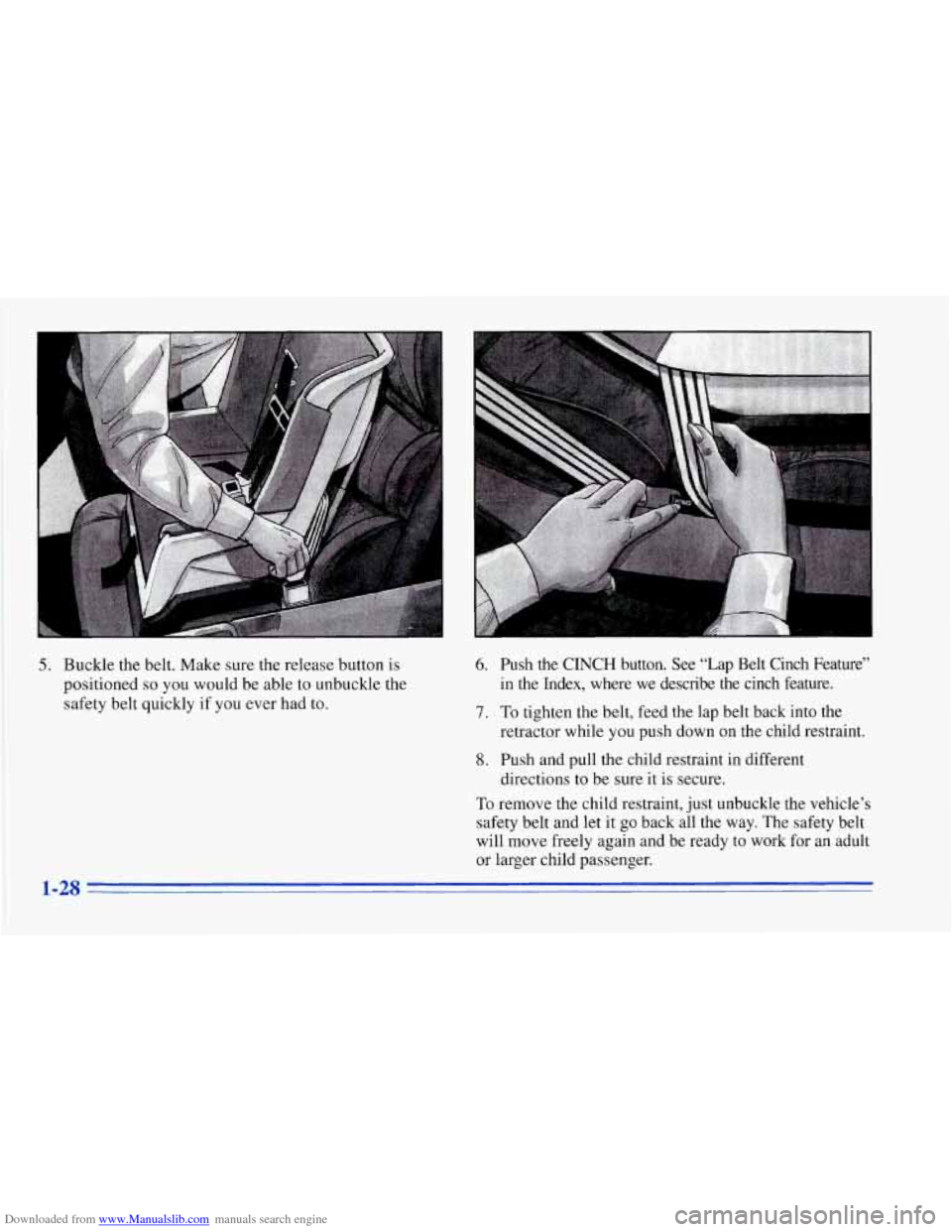
Downloaded from www.Manualslib.com manuals search engine 5. Buckle the belt. Make sure the release button is
positioned
so you would be able to unbuckle the
safety belt quickly
if you ever had to.
6. Push the CINCH button. See “Lap Belt Cinch Feature”
in the Index, where
we describe the cinch feature.
7. To tighten the belt, feed the lap belt back into the
retractor while
you push down on the child restraint,
8. Push and pull the child restraint in different
To remove the child restraint, just unbuckle the vehicle’s
safety belt and let it
go back all the way.. The safety belt
will move freely again and be ready to work for an adult
or larger child passenger. directions
to be sure
it is secure.
28
Page 40 of 386
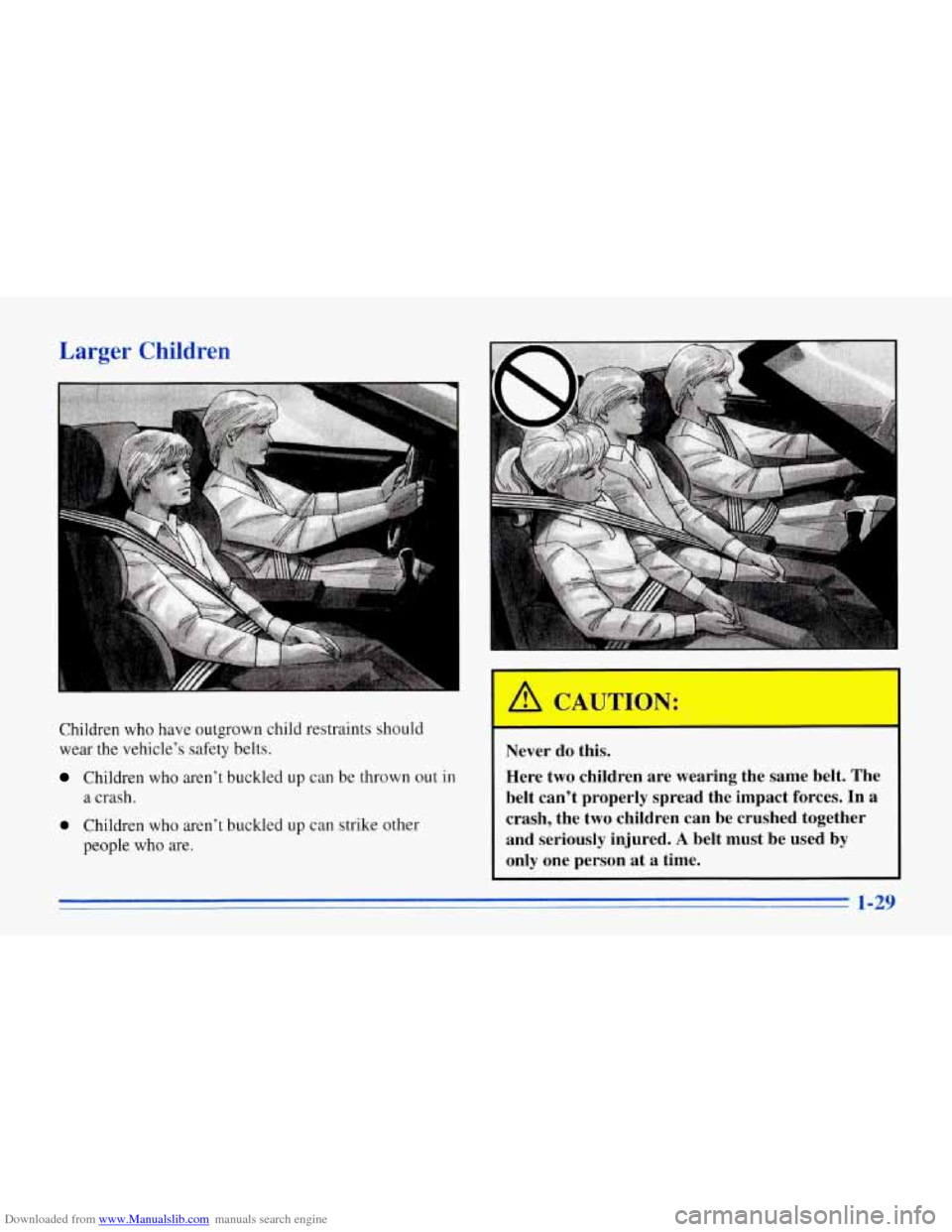
Downloaded from www.Manualslib.com manuals search engine Larger Children
Children who have outgrown child restraints should
wear the vehicle’s safety belts.
Children who aren’t buckled up can be thrown out in
a crash.
0 Children who aren’t buckled up can strike other
people who are.
Never do this.
Here two children are wearing the same belt. The
belt can’t properly spread the impact forces. In a
crash, the two children can be crushed together and seriously injured.
A belt must be used by
only one person at a time.
1-29